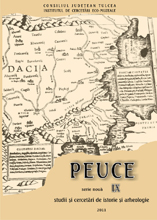The Capitoline Triad in Roman Dacia
The Capitoline Triad in Roman Dacia
Author(s): Maria-Corina NicloaeSubject(s): Archaeology
Published by: Institutul de Cercetari Eco-Muzeale Tulcea - Institutul de Istorie si Arheologie
Keywords: Jupiter; Juno; Minerva; iconography; Capitoline Triad; Dacia; Iuno; iconografie; Triada capitolină; Dacia
Summary/Abstract: Jupiter was the central religious figure within the Roman Empire, especially as Optimus Maximus, who formed a triad together with Juno and Minerva. The worship of these deities was an official act which had the role of assuring the devotion towards the Empire and the Emperor. This circumstance is expressed by the standardization of the inscription formula, and also by the iconography of the three deities within the Capitoline Triad. Worshipping Jupiter, Juno and Minerva has less to do with personal religion, than with the religious policy of the Empire. Their presence in Roman Dacia is attested mainly through inscriptions, thus emphasizing the official character of the cult. Furthermore, the standardized iconography of the members of the Capitoline Triad sustains the hypothesis of political rather than personal religious options. Rezumat: Jupiter era figura centrală a panteonului Imperiului Roman, fiind adorat ca Optimus Maximus, formând o triadă împreună cu Iuno şi Minerva. Închinarea în faţa acestor divinităţi era un act oficial ce avea rolul de a asigura devotamentul atât faţă de statul roman, cât şi faţă de împărat. Această situaţie este exprimată de limbajul standardizat folosit în inscripţiile dedicate acestora, dar şi de iconografia celor trei divinităţi reprezentate în artă sub forma Triadei capitoline. Astfel, se observă că actul de devoţiune faţă de Jupiter, Iuno şi Minerva are de-a face mai puţin cu opţiunea personală, cât mai mult cu politica religioasă a Imperiului. Prezenţa acestora pe teritoriul Daciei este atestată mai ales prin intermediul inscripţiilor, subliniindu-se astfel caracterul oficial al cultului, în timp ce iconografia lor, profund standardizată, susţine ideea unor opţiuni mai degrabă politice decât personale.
Journal: Peuce (Serie Nouă) - Studii şi cercetari de istorie şi arheologie
- Issue Year: IX/2011
- Issue No: 9
- Page Range: 291-305
- Page Count: 14
- Language: English

